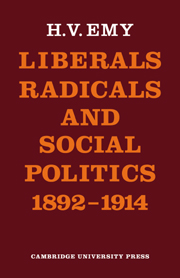Book contents
3 - Regrouping and recovery 1895–1905
Published online by Cambridge University Press: 04 May 2010
Summary
Defeat in 1895 left the Liberal party lacking in two respects, in effective leadership, and in a unified programme behind which the party could gather. The first factor is primarily the story of the eclipse of Rosebery, the failure of Harcourt and Morley to fill his place, and the effective consolidation of Sir Henry Campbell-Bannerman as leader. This is the story of the South African war and the struggle of imperialists and pro-Boers, and this is, primarily, a well-told story. To gain a fuller appreciation of the nature and significance of the changes occurring in the Liberal party between 1895 and 1905, it is necessary to look beneath the surface into the movements occurring first amongst the Radicals themselves, secondly within the organisational sphere and the recovery of Liberalism in the country, and thirdly amongst the personnel of the parliamentary party. When these are linked (in the next chapter) to the movement in ideas, it is possible to see that by 1905 the Liberal party, and the kind of Liberalism it embodied, had changed considerably from the state of 1895.
THE RADICALS
Outwardly, the Radicals were a weak force between 1895 and 1900. Their two most experienced leaders, Labouchere and Dilke, were both distrusted within the party. The former was on bad terms with Rosebery, while Dilke had voted against his party in the critical (cordite) division which led to the fall of the Liberals.
- Type
- Chapter
- Information
- Liberals, Radicals and Social Politics 1892–1914 , pp. 64 - 103Publisher: Cambridge University PressPrint publication year: 1973
- 1
- Cited by



